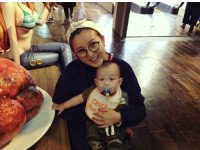UVa 227 Puzzle
来源:互联网 发布:gameloft的java小游戏 编辑:程序博客网 时间:2024/05/02 04:16
Puzzle
A children’s puzzle that was popular 30 years ago consisted of a 5x5 frame which contained 24 small squares of equal size. A unique letter of the alphabet was printed on each small square. Since there were only 24 squares within the frame, the frame also contained an empty position which was the same size as a small square. A square could be moved into that empty position if it were immediately to the right, to the left, above, or below the empty position. The object of the puzzle was to slide squares into the empty position so that the frame displayed the letters in alphabetical order.
The illustration below represents a puzzle in its original configuration and in its configuration after the following sequence of 6 moves:
1) The square above the empty position moves. 2) The square to the right of the empty position moves. 3) The square to the right of the empty position moves. 4) The square below the empty position moves. 5) The square below the empty position moves. 6) The square to the left of the empty position moves.
Write a program to display resulting frames given their initial configurations and sequences of moves.
Input
Input for your program consists of several puzzles. Each is described by its initial configuration and the sequence of moves on the puzzle. The first 5 lines of each puzzle description are the starting configuration. Subsequent lines give the sequence of moves.
The first line of the frame display corresponds to the top line of squares in the puzzle. The other lines follow in order. The empty position in a frame is indicated by a blank. Each display line contains exactly 5 characters, beginning with the character on the leftmost square (or a blank if the leftmost square is actually the empty frame position). The display lines will correspond to a legitimate puzzle.
The sequence of moves is represented by a sequence of As, Bs, Rs, and Ls to denote which square moves into the empty position. A denotes that the square above the empty position moves; B denotes that the square below the empty position moves; L denotes that the square to the left of the empty position moves; R denotes that the square to the right of the empty position moves. It is possible that there is an illegal move, even when it is represented by one of the 4 move characters. If an illegal move occurs, the puzzle is considered to have no final configuration. This sequence of moves may be spread over several lines, but it always ends in the digit 0. The end of data is denoted by the character Z.
Output
Output for each puzzle begins with an appropriately labeled number (Puzzle #1, Puzzle #2, etc.). If the puzzle has no final configuration, then a message to that effect should follow. Otherwise that final configuration should be displayed.
Format each line for a final configuration so that there is a single blank character between two adjacent letters. Treat the empty square the same as a letter. For example, if the blank is an interior position, then it will appear as a sequence of 3 blanks - one to separate it from the square to the left, one for the empty position itself, and one to separate it from the square to the right.
Separate output from different puzzle records by one blank line.
Note: The first record of the sample input corresponds to the puzzle illustrated above.
Sample Input
TRGSJ
XDOKI
M VLN
WPABE
UQHCF
ARRBBL0
ABCDE
FGHIJ
KLMNO
PQRS
TUVWX
AAA
LLLL0
ABCDE
FGHIJ
KLMNO
PQRS
TUVWX
AAAAABBRRRLL0
Z
Sample Output
Puzzle #1:
T R G S J
X O K L I
M D V B N
W P A E
U Q H C F
Puzzle #2:
A B C D
F G H I E
K L M N J
P Q R S O
T U V W X
Puzzle #3:
This puzzle has no final configuration.
分析:
用一个数组puz[][]存储puzzle。读入的时候需要解决空格的问题,用gets(),当末尾是空格时,读入时需补充‘ ’。还有遇到了第一次以后读入puz存在回车符的问题,即在读入puz之前需要先读入一个'\n'。代码:
// #define LOCAL#include <cstdio>#include <cstring>#include <cmath>#include <cstdlib>const int MAX_N = 5, MAX_M = 1010;typedef struct{ int x; int y;} loc;char puz[MAX_N][MAX_N];char mov[MAX_M];loc pos;void disp(){ // puts("^^^^^^^^^^^^^^^^"); for (int i = 0; i < MAX_N; i++) { for (int j = 0; j < MAX_N; j++) { printf("%c", puz[i][j]); if (j < MAX_N - 1) putchar(' '); } puts(""); } // puts("^^^^^^^^^^^^^^^^");}void solve(){ bool flag = true; int len = strlen(mov);/* for (int i = 0; i < len; i++) printf("%c", mov[i]); puts("");*/ for (int i = 0; i < len; i++) { switch (mov[i]) { case 'A': if (pos.x == 0) flag = false; else { puz[pos.x][pos.y] = puz[pos.x - 1][pos.y]; puz[pos.x - 1][pos.y] = ' '; pos.x--; } break; case 'B': if (pos.x == 4) flag = false; else { puz[pos.x][pos.y] = puz[pos.x + 1][pos.y]; puz[pos.x + 1][pos.y] = ' '; pos.x++; } break; case 'R': if (pos.y == 4) flag = false; else { puz[pos.x][pos.y] = puz[pos.x][pos.y + 1]; puz[pos.x][pos.y + 1] = ' '; pos.y++; } break; case 'L': if (pos.y == 0) flag = false; else { puz[pos.x][pos.y] = puz[pos.x][pos.y - 1]; puz[pos.x][pos.y - 1] = ' '; pos.y--; } break; default : ; } // disp(); if (flag == false) { // printf("%c\n", mov[i]); break; } } if (flag) { disp(); } else puts("This puzzle has no final configuration."); return ;}int main(){#ifdef LOCAL freopen("in.txt", "r", stdin); freopen("out.txt", "w", stdout);#endif int flag = 0; while (true) { for (int i = 0; i < MAX_M; i++) mov[i] = '\0'; if (flag) getchar(); gets(puz[0]); if (strlen(puz[0]) == 1 && puz[0][0] == 'Z') break; if (strlen(puz[0]) < MAX_N) { puz[0][MAX_N - 1] = ' '; puz[0][MAX_N] = '\0'; } for (int i = 1; i < MAX_N; i++) { gets(puz[i]); if (strlen(puz[i]) < MAX_N) { puz[i][MAX_N - 1] = ' '; puz[i][MAX_N] = '\0'; } }/* puts("\n#############"); puts("check1:"); disp(); puts("\n#############");*/ int sign = 0; for (int i = 0; i < MAX_N; i++) { for (int j = 0; j < MAX_N; j++) if (puz[i][j] == ' ') { pos.x = i; pos.y = j; sign = 1; // printf("(x,y) = (%d,%d)\n", i, j); break; } if (sign) break; } int k = 0; char c; while ((c = getchar()) && c != '0') { if (c >= 'A' && c <= 'Z') mov[k++] = c; } if (flag) { puts(""); } printf("Puzzle #%d:\n", ++flag); solve(); } return 0;}- UVa 227 - Puzzle
- UVa 227 - Puzzle
- Uva-227-Puzzle
- UVa 227 Puzzle
- UVA - 227 Puzzle
- Uva-227 - Puzzle-AC
- UVa 227 - Puzzle
- UVa-227 - Puzzle
- 【Uva 227】 Puzzle
- UVa 227 - Puzzle
- UVa 227 Puzzle
- UVA - 227 Puzzle
- Uva - 227 - Puzzle
- UVA - 227 Puzzle
- UVa 227 Puzzle
- UVA 227 Puzzle
- UVa 227 - Puzzle
- UVa 227 Puzzle
- android json解析
- Centos 6.5 下hadoop2.5.2的HA集群原理讲解以及详细配置(手动切换)
- zoj 1060 && poj 1094 Sorting It All Out
- 基于Python的行为驱动开发实战
- Twitter Bootstrup风格jQuery用户向导插件
- UVa 227 Puzzle
- UVa 146 ID码
- Hadoop2.4.1集群搭建
- 欢迎使用CSDN-markdown编辑器
- 05.sprite_kit前瞻之节点的动画
- 中医治疗硬皮病十三法
- java.util.vector中的vector的详细用法
- opencv+QT+cmake
- POJ 3268 Silver Cow Party(两次Dijkstra求最大值)


